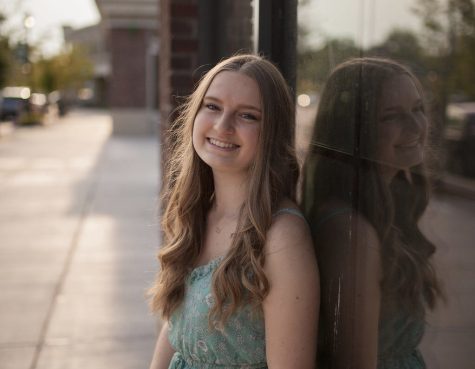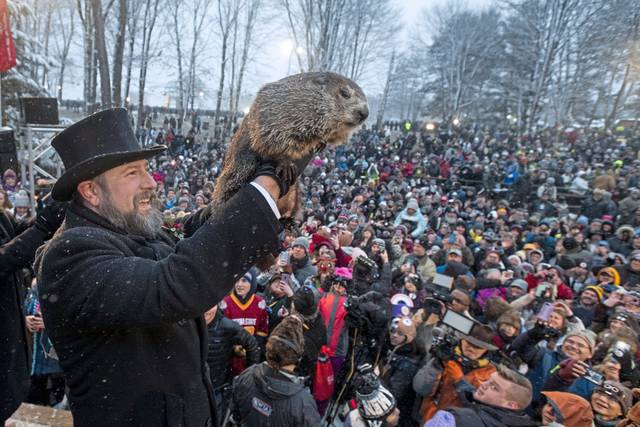Groundhog Day is a longtime American Tradition that is sometimes hidden in the shadows
The groundhog is hoisted into the air after giving its weather prediction.
Since 1886, we have been watching a fifteen-pound rodent act like a meteorologist and predict when our springtime will arrive.
If the groundhog emerges from his little burrow and sees his shadow, it is said that the United States should hunker down for six more weeks and prepare for brutal winter weather. However, if the groundhog does not see his shadow, then it is said that we will experience an early spring.
As far as considering how this “holiday” came to be, social studies teacher Steve Labenz thinks it has little to do with how accurate the creature’s prediction is or not.
“I would imagine by that point, people were really getting tired of winter,” Labenz said. “There were still a lot of rural areas back then, and maybe a lot of people were going crazy, so [they thought], ‘What can we maybe do to make ourselves [feel better]?’ Back then, there obviously were not a lot of meteorological charts. They didn’t have that, so maybe [they] just [did it] to help people feel better about a long, cold winter.”
The first Groundhog Day celebration held in Punxsutawney, Pennsylvania featured Phil, “America’s only true weather-forecasting groundhog.” Even before that first celebration of Groundhog Day, the tradition is said to stem from an ancient Christian celebration known as Candlemas Day: a day that marked the midpoint between the winter solstice and spring equinox.
The legend of Candlemas was that if the sky was clear and cloudless on that day, people could expect a long winter ahead of them. But if the sky was cloudy and grey, warmer weather could be expected soon. This idealism very closely parallels what Groundhog Day practices in the modern day. The tradition was carried over to America by the Germans, and Groundhog Day was born.
As for its relevance in this day and age, the popularity of the holiday seems to deviate from person to person.
“With everything else that goes on in the world,” Labenz said, “I don’t know if people pay that much attention to [Groundhog Day] anymore. I think it’s kind of a relic, but I think for older people, they kind of hold on to it, and over time, maybe in Punxsutawney, it’ll still be a thing because it’s become such a thing for them, but it might be one of those traditions that kind of [trails off]. I don’t think young people would even know that much about it.”
At least for junior Emma Raisch, Labenz’s prediction rings true. She doesn’t really give much thought to Groundhog Day when it comes around each year.
“I haven’t really thought much about Groundhog Day and whether or not the theory is accurate,” Emma said, “but I feel like there’s more to the changing of the seasons than shadows alone.”
Most people don’t rely on the fluffy creature to accurately predict their weather but rather buy into the historic day more for the fun of the whole idea.
“It’s just fun, you know; you do want to believe,” Labenz said. “It’s so rare that we have an early spring, and all the years that I’ve taught here, I can count on one hand how many decent weeks we’ve had for spring break. Even the first week of April, we’ve had snow—there have been plenty of years with snow. I think it makes people feel better that winter is almost done.”
Math teacher Brian Pierce also has a bit of fun surrounding Groundhog Day, despite agreeing with the majority of people that the prediction is not likely accurate.
“It’s not that I don’t believe in it,” Pierce said. “See, it’s almost like Santa Claus; you know he’s not real, yet the belief of it just makes you happy, and you still buy into it.”
And unlike Labenz, Pierce believes the popularity of Groundhog Day has actually increased over the years, and his reasoning is the movie Groundhog Day (1993), starring Bill Murray.
The movie is about a cynical TV weatherman that finds himself reliving the same day over and over again. This day happens to be Groundhog Day, and he goes and reports the groundhog’s shadow prediction each repeated day. He drives himself nuts as he tries to escape the situation, but he finds that by bettering himself, he can get out of the mess.
The film brought awareness to the somewhat diminishing holiday, and now, the festivals celebrating Groundhog Day each year have only kept growing in size.
“Before the movie [was released], they had like two thousand people go to the festival,” Pierce said. “Now, they have upwards of thirty or forty thousand people go—they even had to move the festival to a different location.”
An avid fan of the movie, he shows it to his Advanced Psychology class each year right around Groundhog Day. Eventually, Pierce hopes to get the chance to experience the festival in person one year.
“My family is actually looking at going the next time—I think in 2027—Groundhog Day is on a weekend,” Pierce said, “and so we’re looking at going to Punxsutawney to watch the festival.”
Whether people actually buy into the whole concept of Groundhog Day and find interest in the festivals or not, most can agree that it is still fun to make a prediction.
“He’ll definitely see his shadow [this year]—we will have ten more weeks of winter,” Labenz said. “I always think the middle of April, here, is when spring actually starts, so we’ve got a ways to go.”
Pierce has a similar prediction: “It’s going to be whichever one is the longest; that’s what’s going to happen this year.”
Emma agrees with Labenz and Pierce that, in typical Michigan fashion, we can expect to have a rather chilly spring, and the groundhog will see his shadow this year on Feb. 2.
“If I had a prediction,” Emma said, “it would probably be similar to last year with the fact that we had less snow around December and more in the later months of winter.”

Liza McCarthy is a senior who is excited for her second and final year on staff. This year, she is taking on the new role of Podcast Manager which will...

























































































